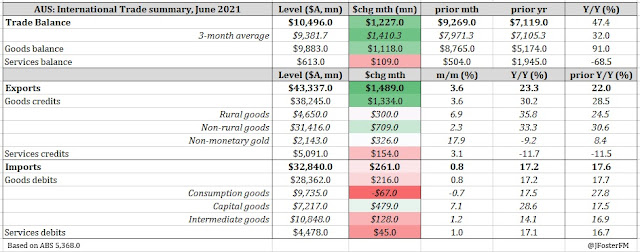Australia's trade surplus has reached a new record high rising to $10.5bn in June. Elevated commodity prices have boosted earnings from the nation's exports to their highest level in 2 years. Import spending continued its upward trajectory from the depths of the COVID recession but remains sharply down on pre-pandemic levels.
International Trade — June | By the numbers
- Australia's monthly trade surplus increased by $1.2bn in June to a new record high of $10.5bn, matching market estimates. May's surplus was revised down to $9.3bn from $9.7bn.
- Export earnings lifted by 3.6% in the month to $43.3bn. May's increase was revised down from 6.1% to 4.5%. Exports are 23.3% higher than 12 months ago when much of the global economy was ground to a halt by lockdowns.
- Import spending was 0.8% higher over the month at $32.8bn, while the 2.9% rise in May was unrevised. Annual growth in imports was 17.2% to be little changed from the month prior (17.6%).
International Trade — June | The details
Surging commodity prices have underpinned another strong lift in earnings from exports in June, the outcome driving the monthly trade surplus to a record high at $10.5bn. This followed surpluses of $8.4bn in April and $9.3bn in May, with the aggregate for the June quarter summing to $28.1bn — also a record and significant windfall to national income just as the economic recovery has been stalled by lockdowns.
Export earnings were $125.2bn in the June quarter to be up by 6.1% from Q1, while import spending was $97.1bn (+3.7%) over the period. Much of the rise in exports can be attributed to higher prices, meaning volume growth in net exports is likely to be negative again after subtracting from GDP in Q1.
In June, the 3.6% rise in exports was broad based but roughly half of the increase came from non-rural goods (2.3%m/m). Within this category, all the key commodities lifted — iron ore 1.9%, coal 5.0% and LNG 2.5% — reflecting higher prices. For the quarter, earnings from non-rural goods surged up by 10%. Rural goods exports advanced to a new record level at $4.7bn, resetting the high from the previous month to be up 6.7% in Q2. Cereal, wool and meat exports all contributed significantly over the past 3 months. Services exports were 3.1% higher in the month but flat over the quarter. The tourism component saw a 3.3% lift in Q2, pointing to the impact of the travel bubble with New Zealand before its recent suspension.
For imports, total spending firmed by 0.8% in June after rising by 2.9% in May. Australia's economic recovery effort has driven spending up by 17.2% from the lows reached during the national lockdown. But imports are still well short of pre-pandemic levels, with one of the major reasons being the ban on overseas travel, except for the period when two-way travel to NZ was allowed. Capital goods (7.1%) drove the rise in imports in June with machinery and industrial equipment the key contributor. Despite a soft Q1 falling by 2.2%, capital goods rebounded by 2.4% in Q2 and are trending higher in response to the recovery in domestic economic conditions and to tax incentives brought in to encourage investment. Consumption goods rose to very elevated levels as households diverted spending away from services due to social distancing measures, with vehicles rising very strongly. This now appears to be leveling out, with consumption goods down 0.7% in June and -0.4% in Q2. Intermediate goods continue to rebound in line with the broader recovery rising by a further 6.2% in the June quarter after an 8.6% lift for Q1. Services imports gained 1.0% in the month but were up noticeably in Q2 (9.4%). Tourism spending remains at very low levels, though it did rise by 187% over the most recent quarter — almost certainly a reflection of the NZ travel bubble arrangement.
International Trade — June | Insights
All in all, the key takeaway from today's report was the boost to the nominal side of the economy from elevated commodity prices. However, net exports are likely to subtract from GDP in Q2 after taking away 0.6 percentage points from output in Q1.






